Introduction
There was no central court in England at the time of Norman Conquest in 1066. The law applied in the various courts was customary, varying from one locality to another and a small body of rules having its source in legislative enactments of the King. A large number of local courts existed in England.
England, during Anglo-Saxon period, was divided first, into Shires, each Shire having a Shire or County court. Shires were further divided into Hundreds. Each Hundred had a Hundred court. Finally each Hundred was divided into townships or Vills. Both Shire and Hundred had a separate court while Vills were a unit primarily for police organization rather than for the administration of justice. After the Norman conquest, these courts were retained when the feudal jurisdiction became the general rule.
The local courts were either courts of different communities into which the country was divided or they were courts, which were held by large landowners.
The courts held by communities were known as Communal courts and the courts held by large landowners were known as Franchised courts or the courts of Seigniorial jurisdiction.
A. Communal Courts
The communal courts were mainly divided into two. They were the Shire or County court and the Hundred court.
1. The Shire or County Court
The three principal officers of the Shire before the Norman conquest were the Alderman, Bishop and Shire-Reve or Sheriff. After Norman conquest, the Sheriff gained importance and became the first man in the country. As a result, the Sheriff became more closely associated with the royal authority. He remained the chief personnel in the county until the Lord's Lieutenant was introduced.
The Shire or County court consisted of the 'suitors' i.e. persons owing suit of the court by reason of feudal landholdings. When they met,


